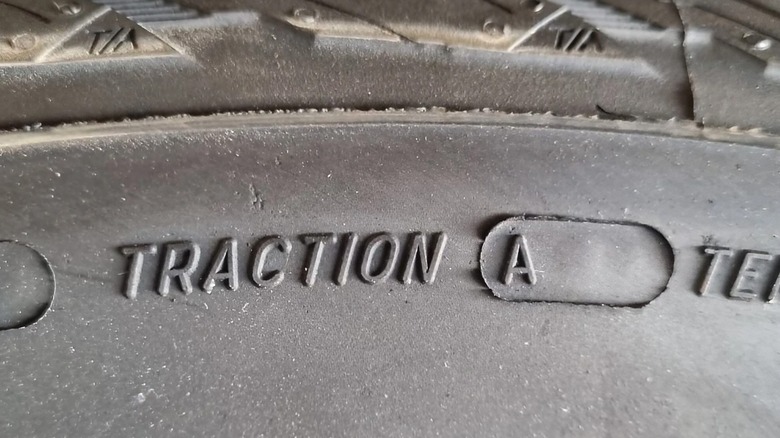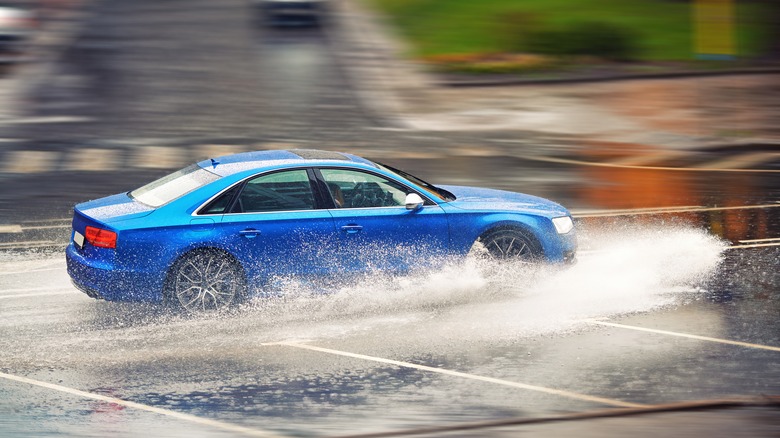What Does The Tire Traction Rating Mean And How Is It Measured?
You probably know that some of the alphabet soup on your tire's sidewall refers to its model and size, but tucked in with those details are also crucial safety grades. Among the most important is the tire traction rating. This is a system developed by the U.S. Department of Transportation's National Highway Traffic Safety Administration and is a key part of their Uniform Tire Quality Grading (UTQG) standard. The point is to help you make informed choices per the driving conditions. Specifically, the scores rate a tire's ability to stop on wet pavement.
The grades range from 'AA' at the top, followed by 'A', 'B', and 'C'. A higher grade means the tire can stop in a shorter distance on a wet surface. Typically, those coveted 'AA' alphabets are ultra-high-performance tires designed for sports cars. It's no surprise that the manufacturers behind these high-performance 'AA' tires are often the same major tire brands ranked highest for their overall quality and innovation. Meanwhile, tires with other ratings are more modest.
How is tire traction measured?
As for the process for determining a tire's traction grade, it's highly standardized. The tests are conducted on government-monitored skid pads, using both asphalt and concrete surfaces, which are built to specific federal standards. During the test, a tire is fitted onto a skid trailer, which is then pulled behind a truck at a consistent 40 mph over the wet test surfaces. When the brakes are locked and the tire slides, it reveals the tire's coefficient of friction — or, in other words, its braking G-force.
The resulting values determine the grade. For an 'AA' rating, a tire must achieve a G-force above .54 on asphalt and 0.38 on concrete. For an 'A' rating, it's above .47 on asphalt and 0.35 on concrete. A 'B' requires above .38 on asphalt and 0.26 on concrete, and a 'C' rating signifies performance of less than .38 on asphalt and 0.26 on concrete.
How should traction ratings influence your tire buying decision?
When using these grades to make a decision, remember that not all tires will have them. Some specific types, such as winter/snow tires, deep-treaded light truck tires, and temporary spares are not required to have UTQG markings. But for the vast majority of tires that do have a rating, the story isn't as simple as just picking the highest grade.
For most daily driving scenarios in North America, tires rated 'A' for traction are perfectly adequate. According to online tire seller Tire Agent, this is also the most popular rating in the U.S., bought by the vast majority of car owners. B is rarer, while C has a virtually non-existent market share.
A critical point to remember is that these grades apply to the tire's performance when it is brand new. This is because as the tread wears down, so does its ability to grip. There is often a direct trade-off between a tire's traction and its tread life. Softer rubber compounds that provide superior grip tend to wear out faster. This means those 'AA' performance tires might offer incredible stopping power, but won't last as long as a harder, more durable tire. Your driving habits, road conditions, and even proper tire inflation play a huge role in real-world traction.
Therefore, while a high traction rating is a good indicator of safety, it should be balanced with other factors like tread wear ratings and your personal driving needs. If you're looking for real-world examples of top-performing tires in wet conditions, SlashGear ranked the 10 tires with the highest ratings for wet conditions.


